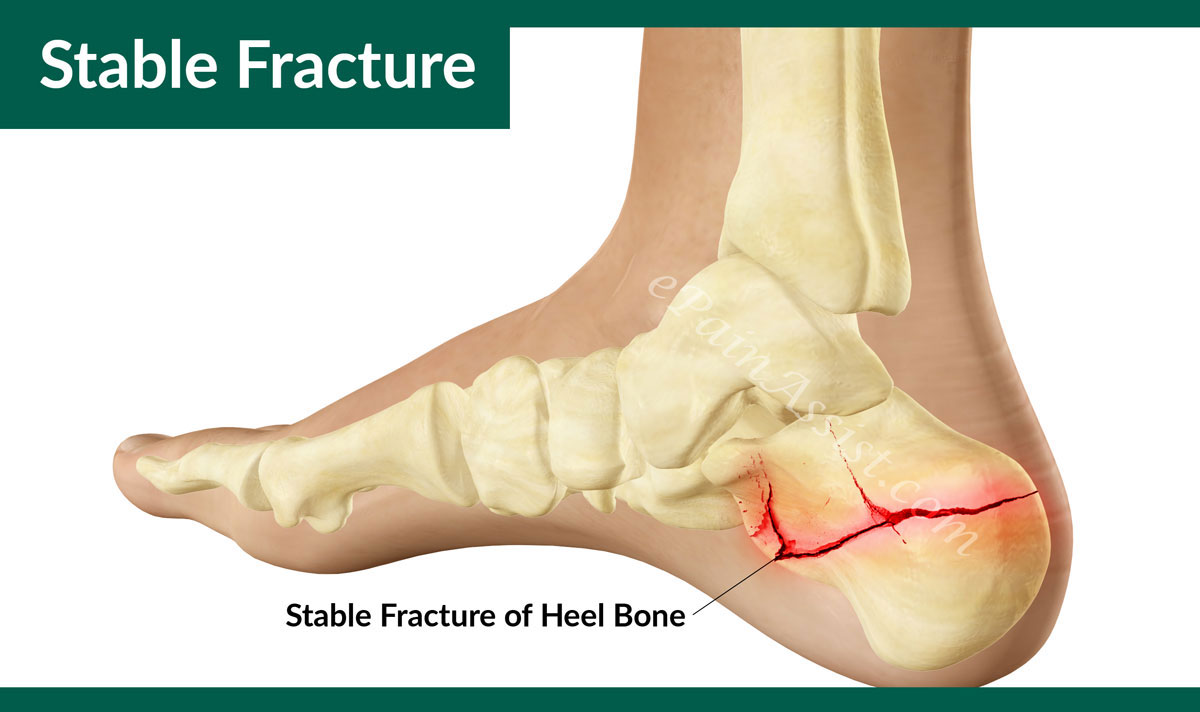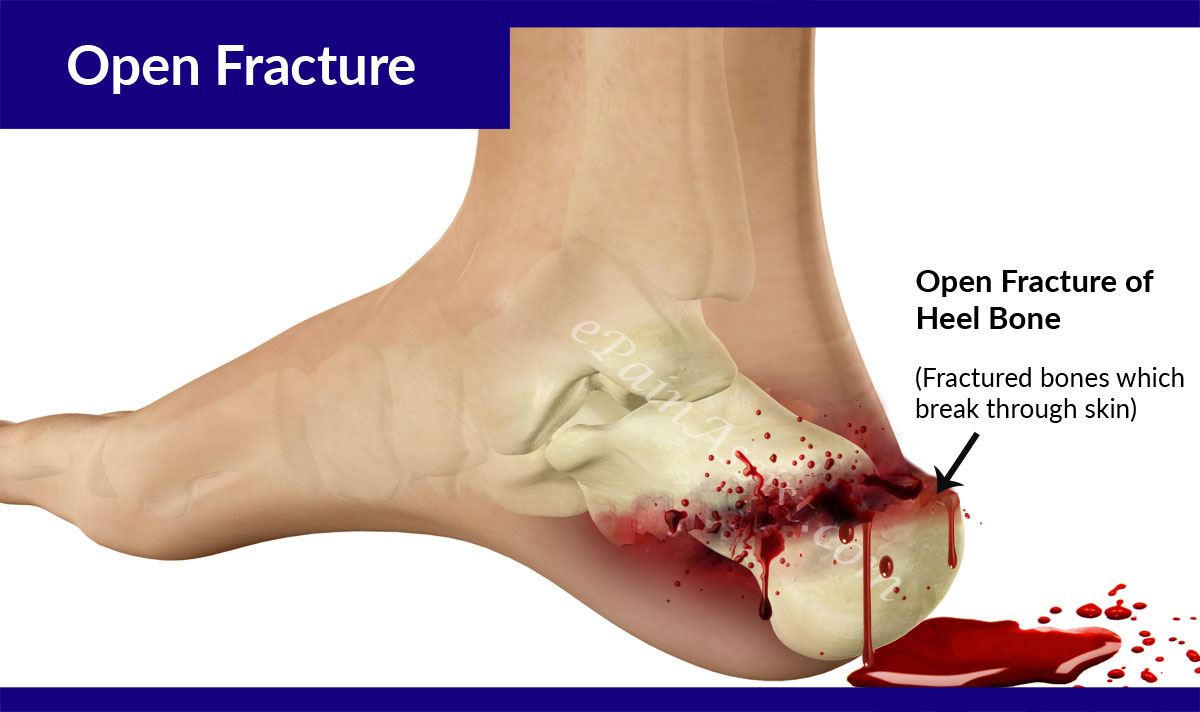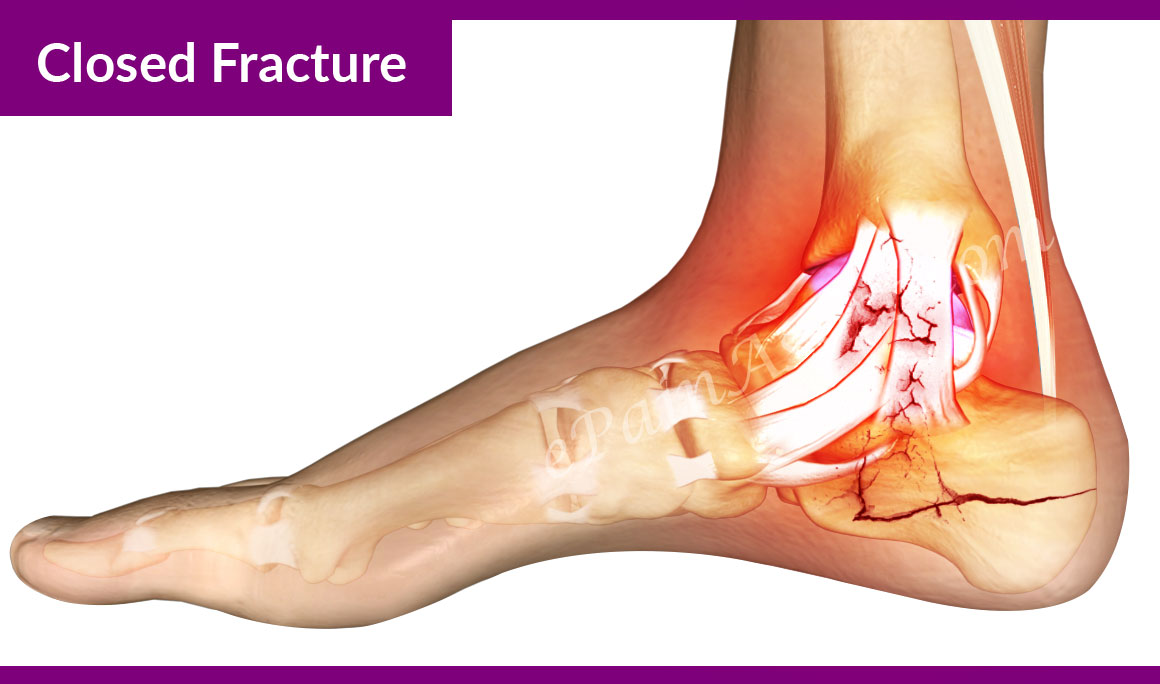What is Calcaneus Fracture or Broken Heel?
A fractured calcaneus or broken heel bone tends to be an extremely disabling injury. This usually occurs as a result of high impact collisions like motor vehicle accidents or falling from a significant height. Calcaneus Fracture or Broken Heel are generally quite severe and result in long term complications for the affected individual. Calcaneal fractures represent 2% of all fractures.1

The injury caused to the heel bone more often than not results in injury to the subtalar joint making it stiff, thus an affected individual finds it difficult to ambulate on uneven grounds.
Types of Calcaneus Fracture or Broken Heel
Calcaneus Fracture or Broken Heel can be of many types, some of which are described below and include:
Stable Fracture of the Calcaneus or Heel Bone: It is a nondisplaced type of fracture of the calcaneus or the heel bone and the bones are acceptably aligned. In this type of fracture, the heel bones generally do not get displaced from their normal position.

Displaced Fracture of the Calcaneus or Heel Bone: In this type of fracture of the calcaneus or heel bone, the bone gets displaced post-fracture. The broken bones are malaligned in this type of fracture. Such fractures usually require surgical procedures to realign them in their normal position.
Open Fracture of the Calcaneus or Heel Bone: Fractured bones which break through skin are known as Open Fractures. Such fractures of the calcaneus or the heel bone tend to cause more damage to the adjoining muscles and tendons and also ligaments. Such fractures take more time to heal and the chances of complications are also quite high.
Closed Fracture of the Calcaneus or Heel Bone: Such fractures of the calcaneus or the heel bone may not break through the skin, but may still severely damage the internal structures.
Comminuted Fracture of the Calcaneus or Heel Bone: Such fractures of the calcaneus or the heel bone are relatively acute and the bone may break into pieces with such fractures. It is an extremely unstable type of fracture of the heel bone.
Causes of Calcaneus Fracture or Broken Heel

Calcaneus Fracture or Broken Heel as a Result of Domestic Fall- Calcaneal bone fracture or broken heel is observed following fall from height or slip on heel.2 Similar injury is also observed following fall while coming down the staircase.
Calcaneus Fracture or Broken Heel as a Result of Motor Vehicle Accident- Automobile accident resulting in head on collision often causes calcaneus fracture or broken heel of driver or passenger sitting next to driver die to the impact.
Sports Injury Resulting in Calcaneus Fracture or Broken Heel – Heel fracture is not a common sports injury. Heel fracture occurs when athlete suffers a direct impact of the heel and simultaneous twist the lower leg.
Calcaneus Fracture or Broken Heel Due To Osteoporosis- Heel fracture is observed in elderly patient and female because of osteoporotic bone disease. Osteoporosis is common disease among menopausal women under 50 years. Fall or moderate impact can result in fracture of calcaneus or broken heel bone in patients suffering with osteoporosis.
Calcaneus Fracture or Broken Heel Caused Due To Stress Fracture- Forceful contraction of tendo achilles, which is attached to calcaneal bone causes stress fracture of calcaneal bone.3
Symptoms of Calcaneus Fracture or Broken Heel
- Symptoms of Excruciating Pain Around the Heel Bone:
- Evidence of Bruising Around the Heel Bone:
- Purple discoloration of skin observed over heel mostly over medial or lateral side below ankle joint.
- Symptoms of Swelling in the Heel Area along with Deformity:
- Swelling around the heel bone is associated with deformity and severe pain.
- Swelling over the heel bone is observed below medial and lateral malleolus.
- Symptoms of Ambulation Difficulties With Calcaneus Fracture of Broken Heel:
- Difficulty in ambulation, especially on uneven surfaces because of fractured heel bone.
- Patient is able to ambulate with crutches or walker by avoiding weight transmission through the fractured heel.
- Inability to walk or carry weight on the leg which has sustained fracture of heel bone.
In very mild forms of Calcaneus Fracture or Broken Heel, walking may not be affected to a large extent as the Achilles tendon comes to the rescue and supports the body weight but still the person may have a limping gait.
Diagnosis of Calcaneus Fracture or Broken Heel
In order to confirm a diagnosis of Calcaneus Fracture or Broken Heel, the treating physician may perform the following studies:
X-rays: This will reveal the extent of the fracture and the type of fracture of the calcaneus or broken heel.
CT Scan: After looking at the x-rays, the physician may then order a CT scan of the foot to look at the internal structures of the foot and to assess the damage that may be caused to the internal structures due to fractured heel bone.4
Treatment For Calcaneus Fracture or Broken Heel
Calcaneus Fracture or Broken Heel is treated first conservatively and if it does not provide adequate pain relief then surgical procedures are contemplated.
Nonsurgical Treatment For Calcaneus Fracture or Broken Heel
This form of treatment is usually done for nondisplaced Calcaneus fracture or displaced broken heel.
- Immobilization- Cast is applied over foot, ankle and lower 2/3rd of the leg. Cast helps to restrict and prevent movements of the fractured fragments of bones and ankle joint.
- Analgesics- Pain is treated with NSAIDs or opioids. NSAIDs are non-steroidal anti-inflammatory drugs like Motrin, Celebrex and Naproxen. Opioids prescribed for chronic pain are hydrocodone and oxycodone.
- Muscle Relaxants- Muscle relaxants like Baclofen, Skelaxin and Flexeril are prescribed for muscle spasm.
Surgical Treatment For Calcaneus Fracture or Broken Heel
Surgical treatment is warranted for calcaneus fractures, which are displaced or open in nature as these fractures result in damage to the internal structures of the foot, which may also need to be repaired. A surgery is usually done after the swelling has calmed down which is done by immobilization and elevation techniques in cases of displaced fracture of the heel bone. This period of immobilization of the heel bone before surgery often results in good outcome postsurgery and reduces the risks inherent to the surgical procedure; however in cases of open fractures, surgery is done emergently.
The Following Procedures are Done as Surgical Treatment of Calcaneus Fracture or Broken Heel:
- Open Reduction Internal Fixation (ORIF) For Calcaneus Fracture: In this procedure, the bony fragments are repositioned or reduced in their normal anatomy. These are then held together with screws and plates.
- Percutaneous Screw Fixation For Broken Heel: There are cases where the bone fragments are quite large in dimensions and are not able to be reduced. In such cases, special screws are placed via small incisions so that the bone fragments are held together.
- Deformity Correction- Fracture of heel or calcaneal bone may be associated with deformity. Deformity is treated with lateral wall decompression, in situ- or corrective subtalar arthrodesis and calcaneal osteotomies accompanied by soft tissue-balancing.5
Watch 3D Video of Surgery for Calcaneus Fracture or Broken Heel, Its Types
Recovery Time For Calcaneus Fracture or Broken Heel
The recovery time for severe or displaced and open fractures of calcaneus bone is usually more than milder and nondisplaced fractures. Individuals with severe forms of fractured heel bone may even be at risk for having permanent loss of function to an extent irrespective of treatment.
Rehabilitation Strategies For Calcaneus Fracture or Broken Heel
The rehabilitation strategies for broken Heel are quite similar for both nonsurgical and surgical cases. Returning to normal routine depends on the severity of the fractured heel bone. It may be about three months before any sort of weightbearing for some, whereas it may be less for others. Some of the rehabilitation strategies for Calcaneus Fracture or Broken Heel are:
Early Motion: Majority of physicians encourage patients with fractured heel bone to begin gentle motion of the foot as soon as the pain calms down a bit. In cases of surgical patients, they are told to start gentle movement of the foot as soon as wound healing is complete.
Physical Therapy (PT): This is the most important aspect of rehabilitation. In this, patients are given exercises to improve range of motion of the affected foot and improve strength of the affected muscles. The exercises may be painful to begin with but the patient needs to overcome it as exercises are vital for return to normal activities in an expedited fashion.
Weightbearing: At the beginning of weightbearing activities, the individual may need a cane or a crutch to walk. The physician’s instruction as to when to put weight on the foot is vital for a speedy recovery from fractured heel bone as putting weight on the affected foot soon may pose a risk of displacing the heel bones.
Complications of Calcaneus Fracture or Broken Heel
Some Complications of Calcaneus Fracture or Broken Heel Are:
- Delayed wound healing
- Irritation of nerves around the site of the incision
- Irritation of tendons due to screws
- Stiffness of joints
- Severe pain.
Some Potentially Serious Complications of Broken Heel Are:
- Blood clots
- Failure of the wound to heal
- Infections
- Bone collapse
- Arthritis.
Long Term Complications of Calcaneus Fracture or Broken Heel
In cases where the internal injuries post-fracture is relatively mild then a patient can return to normal activities in about four to five months postprocedure. In case the fracture is a severe one, then it may even take a couple of years before complete recovery.
Some of The Problems Which Individuals With Broken Heel Face Post-Treatment Are:
- Irritation of the skin.
- Gait abnormalities.
- Chronic pain.
Types of Calcaneus Fracture or Broken Heel
References:
1. Calcaneal fractures: update on current treatments.
Palmersheim K1, Hines B, Olsen BL.
Clin Podiatr Med Surg. 2012 Apr;29(2):205-20, vii.
2. Landing on Your Own Two Feet: A Case Report of Bilateral Calcaneus and Open
Multidetector CT evaluation of calcaneal fractures.
Badillo K1, Pacheco JA, Padua SO, Gomez AA, Colon E, Vidal JA.
Radiographics. 2011 Jan-Feb;31(1):81-92.
3. Bilateral calcaneal stress fractures: a case report.
Imerci A1, Incesu M, Bozoglan M, Canbek U, Ursavas HT.
Ortop Traumatol Rehabil. 2012 Sep-Oct;14(5):477-81.
4. Multidetector CT evaluation of calcaneal fractures.
Badillo K1, Pacheco JA, Padua SO, Gomez AA, Colon E, Vidal JA.
Radiographics. 2011 Jan-Feb;31(1):81-92.
5. Fractures of the calcaneus: current Treatment strategies.
Rammelt S1, Zwipp H.
Acta Chir Orthop Traumatol Cech. 2014;81(3):177-196.






